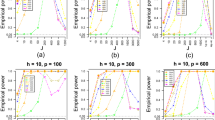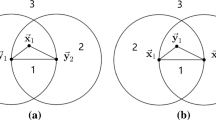Abstract
This paper introduces a novel two-sample test for a broad class of orthogonally invariant positive definite symmetric matrix distributions. Our test is the first of its kind, and we derive its asymptotic distribution. To estimate the test power, we use a warp-speed bootstrap method and consider the most common matrix distributions. We provide several real data examples, including the data for main cryptocurrencies and stock data of major US companies. The real data examples demonstrate the applicability of our test in the context closely related to algorithmic trading. The popularity of matrix distributions in many applications and the need for such a test in the literature are reconciled by our findings.



Similar content being viewed by others
References
Alba-Fernández, M., Batsidis, A., Jiménez-Gamero, M. D., Jodrá, P. (2017). A class of tests for the two-sample problem for count data. Journal of Computational and Applied Mathematics, 318, 220–229.
Alfelt, G., Bodnar, T., Tyrcha, J. (2020). Goodness-of-fit tests for centralized Wishart processes. Communications in Statistics-Theory and Methods, 49(20), 5060–5090.
Baringhaus, L., Kolbe, D. (2015). Two-sample tests based on empirical Hankel transforms. Statistical Papers, 56, 597–617.
Baringhaus, L., Taherizadeh, F. (2010). Empirical Hankel transforms and its applications to goodness-of-fit tests. Journal of Multivariate Analysis, 101(6), 1445–1457.
Baringhaus, L., Taherizadeh, F. (2013). A KS type test for exponentiality based on empirical Hankel transforms. Communications in Statistics-Theory and Methods, 42(20), 3781–3792.
Bibinger, M., Hautsch, N., Malec, P., Reiss, M. (2019). Estimating the spot covariation of asset prices-statistical theory and empirical evidence. Journal of Business and Economic Statistics, 37(3), 419–435.
Chu, J., Nadarajah, S., Chan, S. (2015). Statistical analysis of the exchange rate of bitcoin. PLoS ONE, 10(7), 1–27.
Cuparić, M., Milošević, B., Obradović, M. (2022). New consistent exponentiality tests based on V-empirical Laplace transforms with comparison of efficiencies. Revista de la Real Academia de Ciencias Exactas, Físicas y Naturales Serie A Matemáticas, 116(1), 42.
Dellaportas, P., Pourahmadi, M. (2012). Cholesky-GARCH models with applications to finance. Statistics and Computing, 22, 849–855.
Ding, S., Dennis Cook, R. (2018). Matrix variate regressions and envelope models. Journal of the Royal Statistical Society Series B: Statistical Methodology, 80(2), 387–408.
Dörnemann, N. (2023). Likelihood ratio tests under model misspecification in high dimensions. Journal of Multivariate Analysis, 193(105), 122.
Fruehwirt, W., Hochfilzer, L., Weydemann, L., Roberts, S. (2021). Cumulation, crash, coherency: A cryptocurrency bubble wavelet analysis. Finance Research Letters, 40(101), 668.
Gallaugher, M. P., McNicholas, P. D. (2018). Finite mixtures of skewed matrix variate distributions. Pattern Recognition, 80, 83–93.
Giacomini, R., Politis, D. N., White, H. (2013). A warp-speed method for conducting Monte Carlo experiments involving bootstrap estimators. Econometric Theory, 29(3), 567–589.
Guo, L., Modarres, R. (2020). Testing the equality of matrix distributions. Statistical Methods and Applications, 29, 289–307.
Gupta, A. K., Nagar, D. K. (1999). Matrix variate distributions (Vol. 104). New York: CRC Press.
Hadjicosta, E. (2019). Integral transform methods in goodness-of-fit testing. Ph.D. thesis, The Pennsylvania State University, Department of Statistics.
Hadjicosta, E., Richards, D. (2020). Integral transform methods in goodness-of-fit testing, I: The gamma distributions. Metrika, 83(7), 733–777.
Hadjicosta, E., Richards, D. (2020). Integral transform methods in goodness-of-fit testing, II: The Wishart distributions. Annals of the Institute of Statistical Mathematics, 72(6), 1317–1370.
Haff, L., Kim, P., Koo, J.-Y., Richards, D. (2011). Minimax estimation for mixtures of Wishart distributions. The Annals of Statistics, 39(6), 3417–3440.
Henze, N., Klar, B. (2002). Goodness-of-fit tests for the inverse Gaussian distribution based on the empirical Laplace transform. Annals of the Institute of Statistical Mathematics, 54, 425–444.
Henze, N., Meintanis, S. G. (2002). Tests of fit for exponentiality based on the empirical Laplace transform. Statistics, 36(2), 147–161.
Henze, N., Meintanis, S. G., Ebner, B. (2012). Goodness-of-fit tests for the gamma distribution based on the empirical Laplace transform. Communications in Statistics-Theory and Methods, 41(9), 1543–1556.
Herz, C. S. (1955). Bessel functions of matrix argument. Annals of Mathematics, 61(3), 474–523.
Inc. T. M. (2023). MATLAB version: 9.14.0.2206163 (R2023a). https://www.mathworks.com
Jiang, D., Jiang, T., Yang, F. (2012). Likelihood ratio tests for covariance matrices of high-dimensional normal distributions. Journal of Statistical Planning and Inference, 142(8), 2241–2256.
Jiu, L., Koutschan, C. (2020). Calculation and properties of zonal polynomials. Mathematics in Computer Science, 14(3), 623–640.
Kaminski, K. M., Lo, A. W. (2014). When do stop-loss rules stop losses? Journal of Financial Markets, 18, 234–254.
Koev, P., Edelman, A. (2006). The efficient evaluation of the hypergeometric function of a matrix argument. Mathematics of Computation, 75(254), 833–846.
Kottarathil, P. (2020). Ethereum historical dataset. https://www.kaggle.com/datasets/prasoonkottarathil/ethereum-historical-dataset?select=ETH_1min.csv, version 2. Accessed 09 April 2023
Kumar, A. S., Ajaz, T. (2019). Co-movement in crypto-currency markets: Evidences from wavelet analysis. Financial Innovation, 5(1), 1–17.
Liu, J., Serletis, A. (2019). Volatility in the cryptocurrency market. Open Economies Review, 30, 779–811.
Meintanis, S., Iliopoulos, G. (2003). Tests of fit for the Rayleigh distribution based on the empirical Laplace transform. Annals of the Institute of Statistical Mathematics, 55, 137–151.
Milošević, B., Obradović, M. (2016). New class of exponentiality tests based on U-empirical Laplace transform. Statistical Papers, 57(4), 977–990.
Moakher, M., Batchelor, P. G. (2006). Symmetric positive-definite matrices: From geometry to applications and visualization. Berlin: Springer.
Muirhead, R. J. (1982). Aspects of multivariate statistical theory. Hoboken: Wiley.
Ouimet, F. (2022). A symmetric matrix-variate normal local approximation for the Wishart distribution and some applications. Journal of Multivariate Analysis, 189(104), 923.
Péli, T. (2023). Assessing the financial performance of the companies that shape the S&P 500 index. Acta Polytechnica Hungarica, 20(3), 9–28.
Pennoni, F., Bartolucci, F., Forte, G., Ametrano, F. (2022). Exploring the dependencies among main cryptocurrency log-returns: A hidden Markov model. Economic Notes, 51(1), e12193.
Shah, A., Chauhan, Y., Chaudhury, B. (2021). Principal component analysis based construction and evaluation of cryptocurrency index. Expert Systems with Applications, 163(113), 796.
Shu, M., Song, R., Zhu, W. (2021). The 2021 bitcoin bubbles and crashes-detection and classification. Stats, 4(4), 950–970.
Thompson, G. Z., Maitra, R., Meeker, W. Q., Bastawros, A. F. (2020). Classification with the matrix-variate-t distribution. Journal of Computational and Graphical Statistics, 29(3), 668–674.
Tomarchio, S. D., Punzo, A., Bagnato, L. (2020). Two new matrix-variate distributions with application in model-based clustering. Computational Statistics and Data Analysis, 152(107), 050.
Uhler, C., Lenkoski, A., Richards, D. (2018). Exact formulas for the normalizing constants of Wishart distributions for graphical models. The Annals of Statistics, 46(1), 90–118.
Yang, L. (2015). An application of principal component analysis to stock portfolio management. Ph.D. thesis, University of Canterbury. Department of economics and finance.
Zielinski, M. (2021). Bitcoin historical data. https://www.kaggle.com/datasets/mczielinski/bitcoin-historical-data, version 7. Accessed 09 April 2023
Acknowledgements
The authors would like to express their deepest gratitude to Professor Donald Richards for his comments, which have significantly improved the paper. The authors would like to thank the Associate Editor and the anonymous reviewer for their useful remarks.
Funding
The work of B. Milošević is supported by the Ministry of Science, Technological Development and Innovations of the Republic of Serbia (the contract 451-03-47/2023-01/200104). In addition, the results of this paper are based upon her work from COST Action HiTEc-Text, functional and other high-dimensional data in econometrics: New models, methods, applications, CA21163, supported by COST (European Cooperation in Science and Technology).
Author information
Authors and Affiliations
Corresponding author
Ethics declarations
Conflict of interest
The authors declare that they have no conflict of interest.
Additional information
Publisher's Note
Springer Nature remains neutral with regard to jurisdictional claims in published maps and institutional affiliations.
Appendix
Appendix
In this section, we aim to examine the behaviour of our test in a well-known theoretical scenario. Note that if \(x_1, x_2, \dots , x_n \in N_p(0, \Sigma )\), then \(X=(x_1, x_2, \dots , x_n)\) follows a matrix-variate normal distribution. Additionally, if \(n \ge p\), then \(X'X>0\) with probability 1 and \(X'X \in W_p(n, \Sigma )\) (Gupta and Nagar 1999, p. 88). We have determined the test powers of the Wishart \(\frac{1}{499}W_d(500, I_d)\) distribution against the \(CMT_d(df, I_d)\), where we computed the sample covariance matrices on \(NCov=500\) random vectors. The parameter df is selected from the set \(\{1, 21, 41, \dots , 501\}\). The results for \(d=2\) and \(d=3\) are presented in Figs. 3 and 4. The test powers are expressed in percentage. The behaviour of our tests is as expected, since as the degrees of freedom increase, the t-distribution becomes closer to the normal distribution. Consequently, the distribution of its covariance matrix becomes closer to the appropriately scaled Wishart distribution, leading to a decrease in test powers and reaching test size for large enough degrees of freedom.
About this article
Cite this article
Lukić, Ž., Milošević, B. A novel two-sample test within the space of symmetric positive definite matrix distributions and its application in finance. Ann Inst Stat Math (2024). https://doi.org/10.1007/s10463-024-00902-z
Received:
Revised:
Accepted:
Published:
DOI: https://doi.org/10.1007/s10463-024-00902-z






